how to do what if analysis data table in excel
Last Updated: Dec thirty, 2021
In this article, I will prove y'all the best types of charts in Excel for data analysis, presentation and reporting inside xv minutes. You will larn virtually the various Excel charts types from column charts, bar charts, line charts, pie charts to stacked surface area charts.
How to select the best excel chart?
The blazon of Excel chart you select for your analysis and reporting depends upon the blazon of information you desire to analyze and report and what you want to exercise with data:
- Visualize data (make sense of information esp. big data)
- Classify and categorize data
- Notice a relationship among information
- Understand the composition of data
- Sympathize the distribution of data
- Understand the overlapping of data
- Decide patterns and trends
- Find outliers and other anomalies in data
- Predict time to come trends
- Tell meaningful and engaging stories to decision-makers
What are the near pop excel charts and graphs types?
Following are the about pop Excel charts and graphs:
- Clustered column chart
- Combination chart
- Stacked cavalcade chart
- 100% stacked column nautical chart
- Bar chart
- Line chart
- Number chart
- Approximate nautical chart (Speedometer nautical chart)
- Pie chart
- Stacked surface area chart
- Venn diagram
- Scatter nautical chart
- Histogram
- Bodily vs. target chart
- Bullet nautical chart
- Funnel chart
When to employ a line chart?
#1 Employ line charts when you desire to prove/focus on data trends (uptrend, downtrend, short term tendency, sideways trend, long term) especially long term trends (i.e. changes over several months or years) between the values of the data series:

#2 Use line charts when you have besides many data points to plot and the apply of cavalcade or bar chart clutters the nautical chart.
#3 Use a line chart instead of a clustered column chart if the order of categories is important:
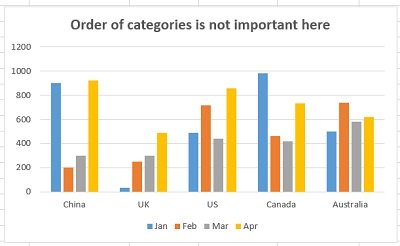

#4 In a line graph, the ten-axis would represent the categories and the y-axis would stand for the measurement values that would be represented periodically.
#5 A line graph should be used when y'all desire to emphasize the changes for values for one variable that are represented in the vertical axis to the other variable represented in the horizontal axis.
#6 Line graphs are ameliorate over bar graphs when in that location are smaller changes.
#7 To read a line graph, commencement examine the 2 axes and understand the value points represented on the graph. The second matter is to figure out if there was a rising or fall in the data.
When to employ a clustered cavalcade chart?
#1 Apply a clustered column chart when y'all want to compare 2 to four information series. In other words, avoid using column charts if you have merely one data series to plot:
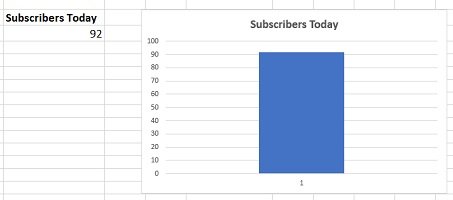
Alternatively, avoid creating a cavalcade chart that has got more four data series.
For instance, the following chart contains but five data serial and it has already started looking chaotic:
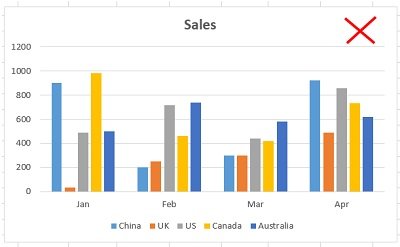
The chart below contains 11 data series and is very difficult to read and understand:
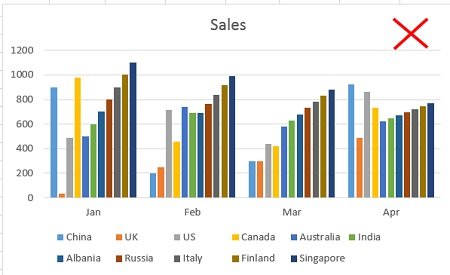
If you desire to create a column chart that contains a lot of information series then you tin effort switching 'row' and 'column' of the chart and see whether it makes any departure:

For example, after switching the row and column of the nautical chart (with eleven data serial), it looks like the one below:
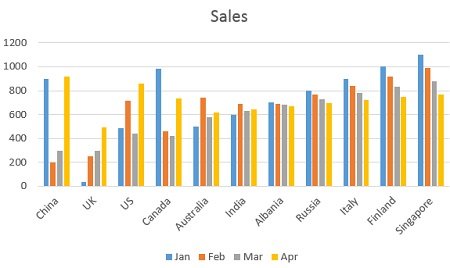
Now this chart, though however look cluttered, is much easier to read and understand.
#2 Although the clustered column chart looks like a elementary column nautical chart, it is slightly different. A simple cavalcade chart is used to represent but a single variable over the other variable, whereas clustered column charts represent multiple information variables.
#3 Use a clustered column chart when the data series yous want to compare have the aforementioned unit. Then avoid using cavalcade charts that compare information serial with dissimilar units of measurement.
For case in the chart beneath 'Sales' and 'ROI' have different units of measurement.
The data series 'Sales' is of type number. Whereas the information series 'ROI' is of type percentage:
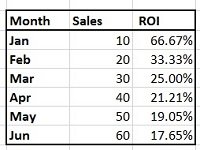

#four Employ a clustered column chart when the information series y'all want to compare are of comparable sizes. So if the values of one data series dwarf the values of the other data serial and then do not utilise the column chart.
For example in the chart below the values of the data serial 'Website Traffic' completely dwarf the values of the data series named 'Transactions':
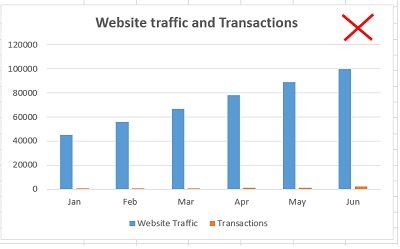
#v Use a clustered cavalcade nautical chart when you desire to evidence the maximum and minimum values of each data series you want to compare.
#6 Use a amassed column chart when y'all want to focus on short term trends (i.e. changes over days or weeks) and/or the gild of categories is not important.
Breaking a amassed cavalcade chart
The chart below contains eleven data series and is very hard to read and understand:
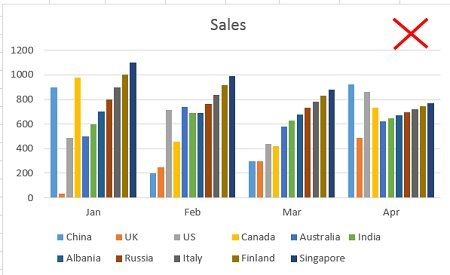
One method of making this chart easier to read and sympathize is by breaking it into several smaller clustered column charts.
For example, you tin create i column chart which just compares the sales performance of various countries in January.
Create some other cavalcade chart which just compares the sales functioning of various countries in February and so on:

The rule of pollex is to avoid presenting too much data in i chart, regardless of the nautical chart type you utilize.
When to employ a combination chart?
A combination nautical chart is simply a combination of two or more charts.
For example the combination of a column chart with a line chart.
I use combination charts a lot and I think you lot must know how to create them equally they are very useful.
#i Use a combination chart when yous desire to compare two or more than data serial that have dissimilar units of measurement:
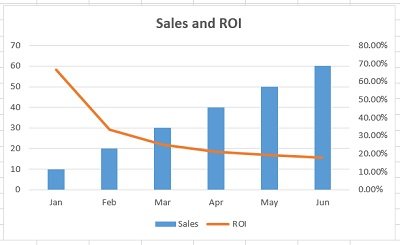
#two Utilise a combination chart when you desire to compare two or more than data series that are not of comparable sizes:
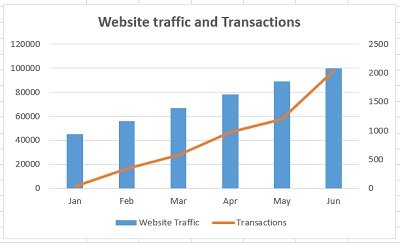
#iii Utilize a combination chart when you want to display dissimilar types of data in different ways that tin can be represented in the same nautical chart. For example, line, bar and cavalcade charts can be used on the aforementioned nautical chart.
When to use a stacked column chart?
Apply a stacked cavalcade chart when you want to compare data series along with their composition and the overall size of each information series is important:
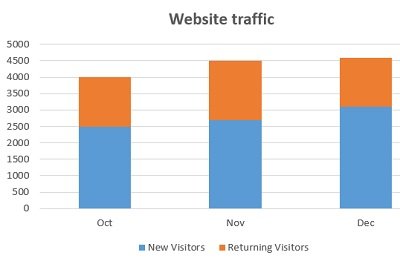
When to use a 100% stacked cavalcade nautical chart?
Use a100% stacked cavalcade nautical chart when you want to compare data series along with their composition but the overall size of each data serial is not of import:
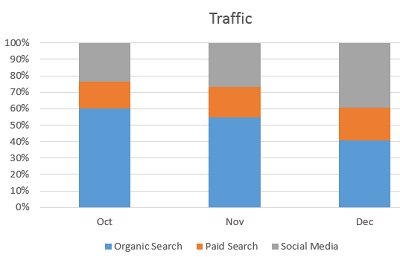
This chart is used to prove the percentage of multiple data serial in stacked columns.
When to use a stacked area chart?
Use a stacked area nautical chart when you lot want to testify the tendency of composition and emphasize the magnitude of change over time.
For case, the post-obit stacked surface area chart shows the breakdown of website traffic:
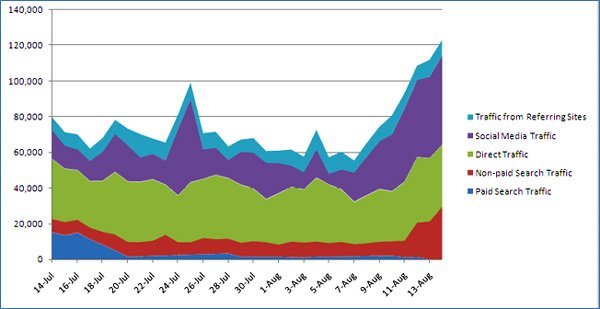
When to utilise a bar chart?
#1 Apply a bar chart whenever the centrality labels are too long to fit in a column chart:
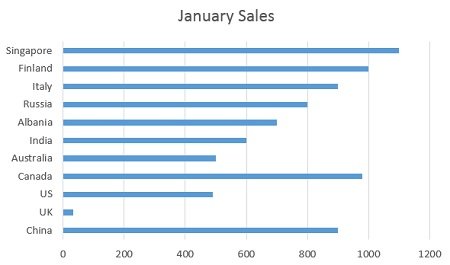
What are the unlike types of bar charts?
Horizontal bar charts – Represents the data horizontally. In this, the information categories are shown on the vertical axis and information values are shown on the horizontal axis.
Vertical bar charts – Also called a column chart. It represents the numerical values represented in the vertical confined. These are used mainly to brandish age ranges, salary ranges.
Grouped bar charts – Grouped bar charts are a combination of representing the different time period numbers that belong to a unmarried category.
Stacked bar charts – Information technology is a bar chart that represents the comparisons between categories of data merely with the ability to compare and break down the data.
When to use a pie chart?
#one Utilise a pie chart when you lot desire to show a 100% composition of information. In other words, the various pie slices you apply must add together upwardly to 100%. What that ways, do not create a pie chart where the diverse pie slices practise non represent parts of the whole pie.
For example, the post-obit pie chart is not a good representation of data composition as the two pie slices add up to 82% and not 100%:
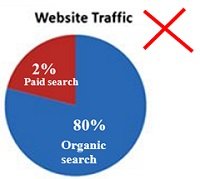
#2 Apply a pie chart to show the composition of data only when you have got i data series and less than 5 categories to plot.
For example, the post-obit pie chart shows the breakdown of website traffic sources in the last month:
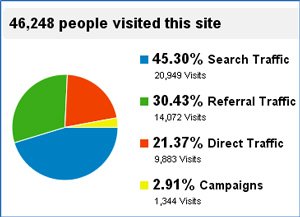
Here I have got only 4 categories (search traffic, referral traffic, direct traffic, and campaigns) to plot. So a pie chart is ideal to testify the breakdown.
However, if there were more than iv categories to plot, similar eight or x categories, and so the pie nautical chart would have get cluttered and difficult to read.
For instance, the post-obit pie nautical chart looks cluttered considering it has got likewise many categories:
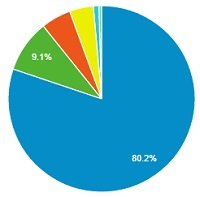
#3 Pie charts generally express the part to the whole human relationship in your information. When your data is represented in 'percentage' or 'office of' and then a pie chart is the best to run into your needs.
#4 Use a pie chart to show data limerick simply when the pie slices are of comparable sizes. In other words, do not employ a pie chart if the size of one pie slice completely dwarfs the size of the other pie slice(south):
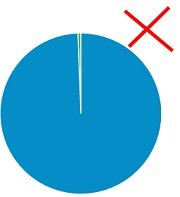
#five Order your pie slices in such a fashion that as you look clockwise from top to bottom, the biggest pie slice comes first followed by the 2d biggest pie slice and then on. This makes the pie nautical chart easy to read:
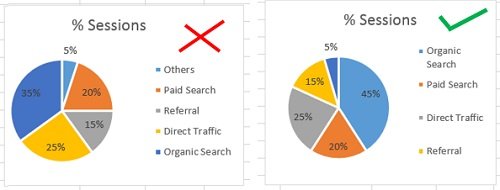
These pie charts are made from the following information:
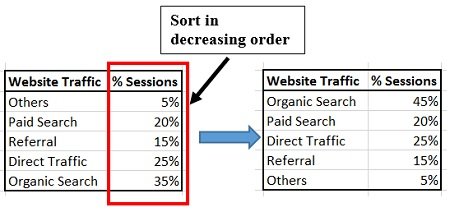
In order to create a pie chart where the biggest pie piece comes beginning followed past the second biggest pie slice and so on.
I have sorted the data in decreasing order (from largest to smallest).
Best practices for using pie charts
Limit the number of pie slices
Always make certain to use a minimal number of slices when creating a pie nautical chart. It is really difficult to read a big number of slices.
If you have more than five categories then information technology is recommended to use a different type of chart.
Make certain all data adds up to 100%
Verify that the pie slices are valued to 100% when added up.
Include annotations: Include percentages and labels for your pie charts to make it easy to read.
Pie charts work best for 25%, l%, 75% and 100%.
Don't compare multiple pie charts
Do not use multiple pie charts for comparison as the slice sizes are really difficult to compare adjacent.
When to use a number chart?
If you desire to visualize merely one type of data and information technology contains a numeric value that does non fall in any range/interval then use the number chart:
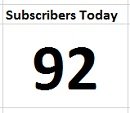
When to use a gauge chart (also known as speedometer chart)?
If you want to visualize just one blazon of information and it contains a numeric value that falls in a range/interval then utilize the gauge nautical chart (also known as speedometer nautical chart):
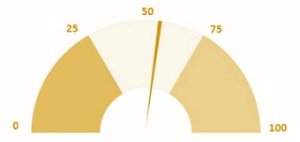
A gauge nautical chart should be used when y'all want to validate if your data falls in the adequate range or not.
A gauge nautical chart would generally accept the maximum value as default and thresholds as depression, medium and high, which indicate if the data is falling inside the acceptable range.
Thresholds would exist displayed red, light-green and yellow for specified values.
When to use a scatter chart?
#1 Consider using a scatter nautical chart when you desire to clarify and study the relationship/correlation between ii variables:
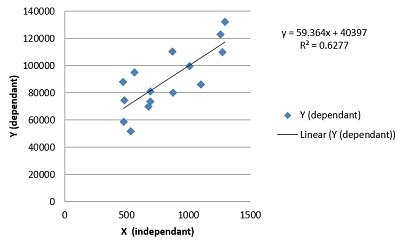
From this chart, we tin conclude that the relationship betwixt the two variables ('x' and 'y') is linear. What that means, as the value of the variable 'x' increases there is a corresponding increase in the value of the variable 'y'.
#2 Create a scatter chart but when at that place are ten or more data points on the horizontal axis. The more information points the better it is for a scatter nautical chart. Conversely, just a few data points (similar 5 or six data points) are not expert plenty for creating a besprinkle chart.
#iii Apply a scatter chart when you desire to testify 'why'. For example: why revenue is correlated with average order value or why conversion rate is correlated with the number of transactions.
When to use a histogram?
Use a histogram to show frequency distribution for quantitative information.
A histogram represents the visual representation of numerical data that falls inside a specified range of values called 'bins'. It looks exactly like a vertical graph.

Annotation: You would demand to install the 'Assay ToolPak' in order to create a histogram in Excel.
When to use an 'actual vs. target' chart?
The chart beneath shows whether target sales were achieved in each quarter:

This nautical chart is based on the post-obit information tabular array:
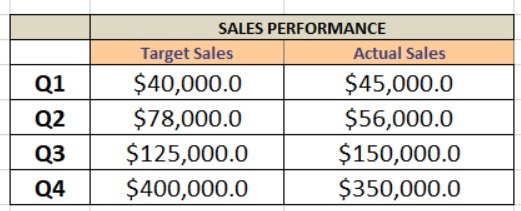
The 'Bodily vs. target' nautical chart is a combination nautical chart that requires some formatting.
Yous tin't insert this chart straightaway into your Excel spreadsheet.
Use this chart when you have got multiple goals and you lot want to bear witness progress towards each goal.
When to use a bullet chart?
The chart below shows the performance of sales in Quarter iv:

This chart is based on the following data table:

If the actual sales are between $0 to $240,000 then sales operation is considered 'Poor'.
If the bodily sales are betwixt $240,000 to $300,000 ($240,000 + $60,000) so it is considered 'Off-white'.
If the actual sales are between $300,000 to $360,000 ($240,000 + $60,000 + $60,000) then information technology is considered 'Good'.
If the bodily sales are between $360,000 to $400,000 ($240,000 + $sixty,000 + $lx,000 + $40,000) and then it is considered 'Fantabulous'.
A Bullet nautical chart is a combination nautical chart (though it looks like a single bar nautical chart) that is used to show progress towards a unmarried goal using a range of predefined qualitative and quantitative parameters.
Yous can't insert this chart straightaway into your Excel spreadsheet and it is as well quite tricky to create.
If you accept multiple goals and you want to show progress towards each goal then use the 'Actual vs. target' chart.
But if you have only one goal and you want to show progress towards this goal (past using both qualitative and quantitative data) then use the bullet chart.
A bullet chart tin can be a vertical bar chart or a horizontal bar chart.
The choice of vertical or horizontal alignment depends on the space bachelor to apply for data visualization.
When to utilise a funnel chart?
Funnel charts are a visual representation of the progressive reduction of data from i phase to another phase.
The first stage is usually referred to equally the intake stage.
The nautical chart beneath shows different stages of the purchase funnel and how users moved from one phase to the next:

This chart is based on the following data table:

As the proper name suggests the funnel chart is used for funnel visualization. It is perfect for showing lead funnel and sales funnels.
A funnel chart provides visual pictures of the stages in the process.
For example, let us take an example of an ecommerce business concern. Funnel charts tin can be used to understand how many users take actually added the products to the cart, provided shipping details and completed the purchase.
Information technology too provides us with information about users who have abandoned the cart.
This chart is available in MS Excel (2016 and above). You only need to select your data table and then insert the 'Funnel' chart.
Funnel charts are mostly used for the sales process and to identify any potential problems.
A funnel consists of a higher value, called the head, and the lower part, which is referred to as the neck.
When to use a Venn diagram?
Use a Venn diagram to show the overlapping of data.
The multi-channel conversion visualizer chart used in Google Analytics to visualize multi-aqueduct attribution is actually a Venn diagram:
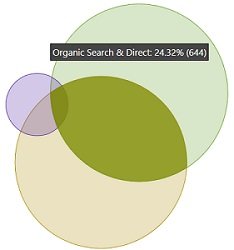
In the context of web analytics, we tin utilize a Venn diagram to make up one's mind whether or not a website has got attribution bug.
If in that location is little to no overlap between ii or more marketing channels so the website doesn't have attribution issues.
If there is a good amount of overlap then the website has got attribution bug and you lot should seriously consider taking multi-channel attribution into account while analyzing and interpreting the operation of marketing campaigns.
To larn more nearly attribution modelling read this article: Beginners Guide to Google Analytics Attribution Modelling
Another great use of Venn diagrams is in visualizing the backlinks overlaps between websites:
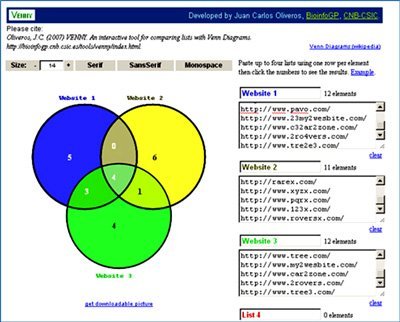
The tool that I take used to create this Venn diagram is known every bit Venny.
Note: You tin can create a Venn diagram in Excel. Cheque out this tutorial on the Microsoft Function website: Create a Venn diagram
What are the different types of Venn diagrams?
Two set diagrams – Two circles overlapping properties. This is the well-nigh mutual and simplest form of Venn diagram used to compare two metrics or variables.
3 set diagrams – This lets you visualize the relationship between three subjects rather than ii variables.
Four set diagram– This comprises four circles overlapping properties. A chip more circuitous than the normal Venn diagram and each circle represents the different aspect of the data and their comparison to other variables.
Which charts to avoid for reporting purposes?
Throughout this article, I have talked about the charts that should be used.
But there are some charts that should be avoided for reporting purposes unless your target audience is as data-savvy as you lot.
Following are those charts:
#1 Charts to avert > Treemap
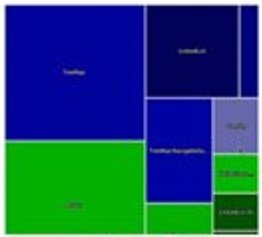
#two Charts to avoid > Waterfall chart
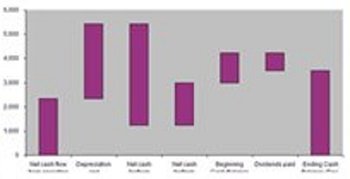
#3 Charts to avoid > Radar chart
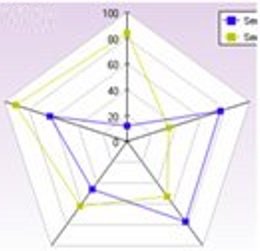
#4 Charts to avoid > Bubble nautical chart
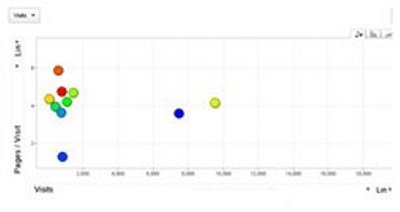
The reason y'all should exist avoiding reporting data via these charts to your clients is simple.
The majority of people have no idea what yous are trying to communicate via these charts.
Use these charts only when your target audience is as data-savvy as you lot.
How to change the chart type in Excel?
MS Excel allows you to change the chart type.
For instance, you can convert a clustered column chart into a stacked cavalcade nautical chart. Or you can convert a column chart into a bar chart.
For example, permit'south convert the post-obit cavalcade nautical chart into a bar chart:
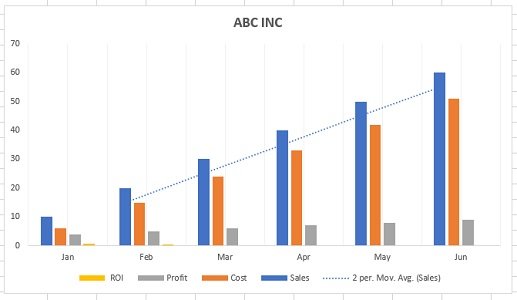
Follow the steps below to change the chart type in excel:
Step-1: Open MS Excel and navigate to the spreadsheet which contains the chart you desire to edit
Step-2: Select the nautical chart and then from the " Design ' tab click on the 'Modify Nautical chart Type' button:

You will at present see the 'Change Nautical chart Type' dialog box like the one beneath:

Footstep-3: Click on 'Bar' (from the left-hand navigation) and and then click on the 'OK' push:
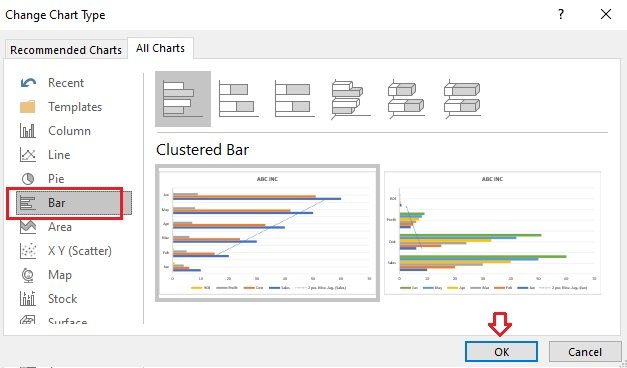
Excel will at present change your column chart into a bar chart:
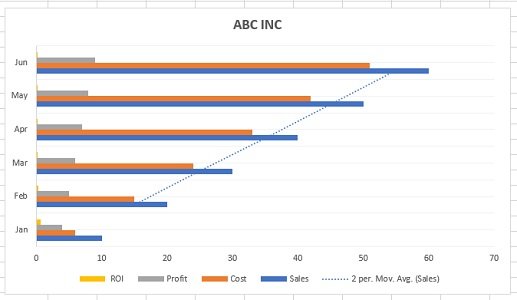
What is information visualization in Excel?
Data visualization is the presentation of data (both qualitative and quantitative data) in graphical format.
In Excel, charts and graphs are used to brand a visual representation of information.
What are the benefits of data visualization
Through data visualization you lot can hands:
- Visualize data (make sense of data, specially big information)
- Classify and categorize data
- Find a relationship among data
- Empathise the limerick of data
- Understand the distribution of data
- Sympathise the overlapping of data
- Decide patterns and trends
- Notice outliers and other anomalies in data
- Predict future trends
- Tell meaningful and engaging stories to conclusion-makers
Information presentation is a very important skill for an optimizer (marketer, analyst). In fact, it is so valuable that LinkedIn lists it as ane of the top skills that tin can get yous hired.
Excel charts are commonly used for information visualization and presentation. Merely selecting the right Excel nautical chart is always a claiming.
If you use an incorrect Excel chart for your assay, you may misinterpret data and make the wrong business and marketing decisions.
If you utilize an incorrect Excel nautical chart for your presentation, then stakeholders may misinterpret your charts and take wrong decisions.
Therefore selecting the right Excel chart is critically important.
What are the virtually common information types that tin exist visualized?
Following are the almost mutual data types that can be visualized:
#one Quantitative data (also known equally interval/ratio information) is the data that can be measured.
For case 10 customers, sales, ROI, weight, etc.
#two Qualitative information is the data that can be classified/categorized only it tin not exist measured.
For instance colors, satisfaction, rankings, etc.
#three Discrete data – quantitative information with a finite number of values/observations.
For example 5 customers, 17 points, 12 steps, etc.
#four Continuous information – quantitative data with value / observation within a range/interval.
For example sales in the last year.
#5 Nominal data – qualitative data that can not be put into a meaningful order (i.due east. ranked).
For case {Blue, Xanthous, Green, Red, Black}
#6 Ordinal information – qualitative data that can be put into a meaningful society (i.eastward. ranked).
For example, {Very Satisfied, Satisfied, Unsatisfied, very unsatisfied} or {Strong dislike, dislike, neutral, like, potent like}
The anatomy of an Excel nautical chart
In order to read an Excel chart, it is important that you sympathise the various components of the chart.
Consider the following data table in Excel:
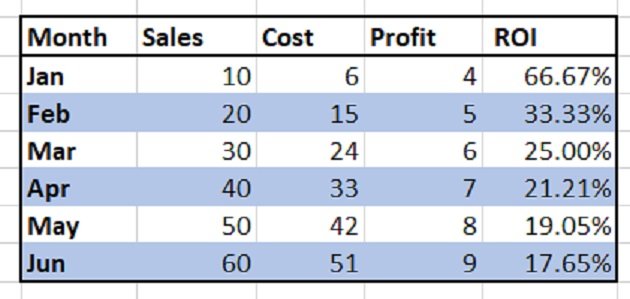
This data table has got five variables: 'Month', 'Sales', 'Cost', 'Profit', and 'ROI':
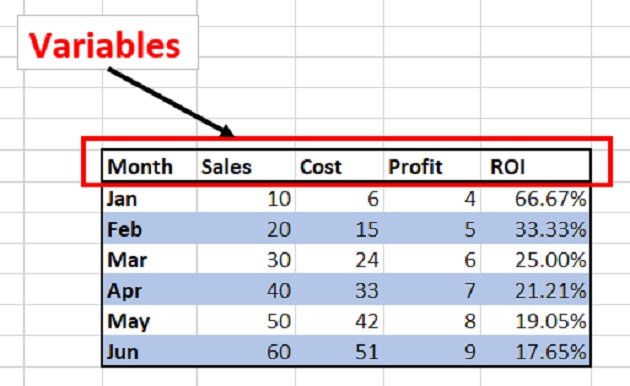
This data table is fabricated up ofcategories and data series:
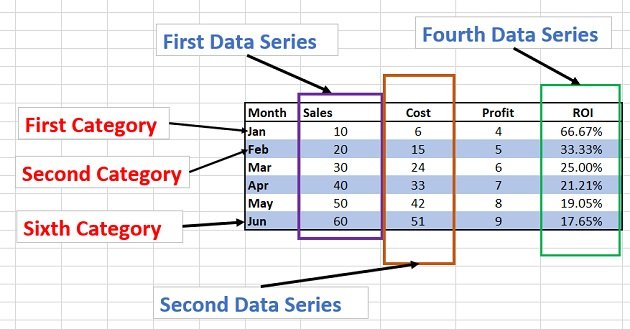
Categories– Here the commencement category is 'Jan', the 2d category is 'Feb', the tertiary category is 'Mar' and and so on.
Data series – A data serial is a set of related data points.
Information point – Data bespeak represents an individual unit of data. x, 20, 30, 40, etc are examples of data points. In the context of charts, a data indicate represents a mark on a chart:
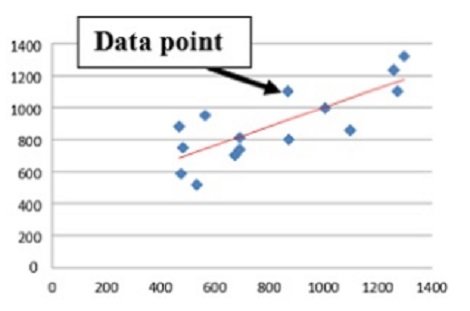
Consider the following Excel chart which is made from the data tabular array mentioned before:
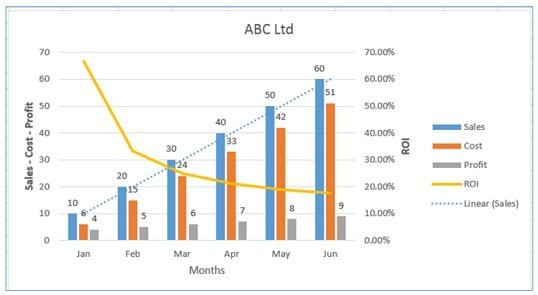
This chart is made up of the following chart elements:

- Primary Horizontal Axis:
- Primary Vertical Axis
- Secondary Vertical Axis
- Primary Horizontal Axis Championship
- Primary Vertical Axis Title
- Secondary Vertical Axis Title
- Nautical chart Championship
- Information Labels
- Gridlines
- Legend
- Trendline
In Excel, categories are plotted on the horizontal axis and data series are plotted on the vertical centrality:
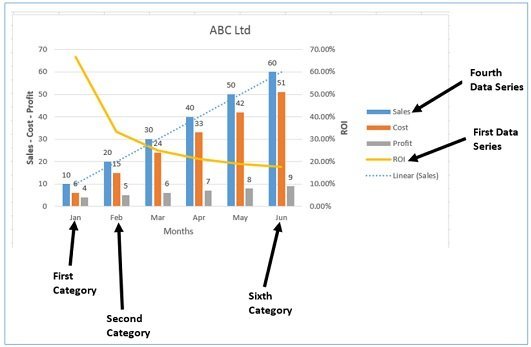
From the chart to a higher place, we can conclude the following:
- Months are plotted on the main horizontal axis.
- Sales, cost, and profit are plotted on the master vertical axis.
- ROI is plotted on the secondary vertical axis.
Following are examples of other Excel nautical chart elements:
- Information Table with legend keys
- Data Table with no legend keys
- Error bars (Standard Error)
- Error confined (Percentage)
- Error confined (Standard Departure)
- Primary Major Horizontal Gridlines
- Primary Major Vertical Gridlines
- Primary Minor Horizontal Gridlines
- Primary Minor Vertical Gridlines
- Linear Trendline
- Exponential Trendline
- Linear Forecast Trendline
- Moving Average Trendline
#1 Data table with legend keys
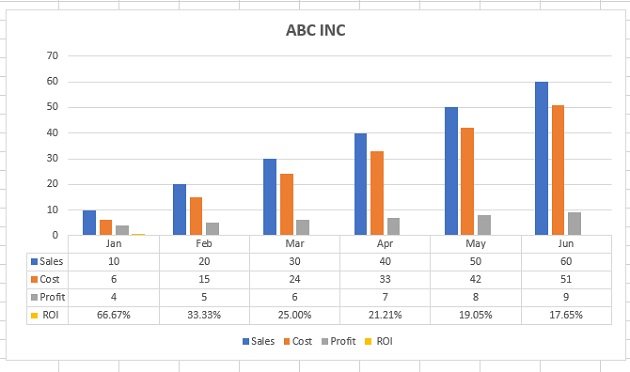
#2 Information table with no legend keys
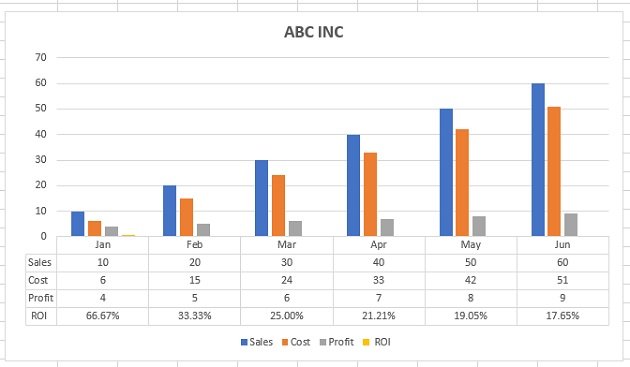
#iii Error confined (standard fault)
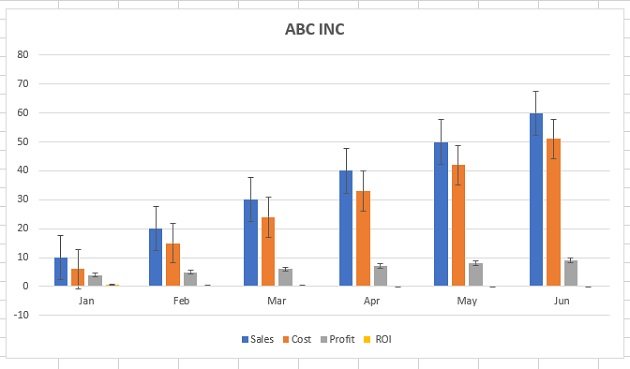
If you desire to run into the margin of error as a standard error amount so use the standard error bar.
About Error Bar
An error bar is a line through a point on a graph, parallel to i of the axes, which tin help you lot see margins of fault at a glance.
#iv Error confined (pct)
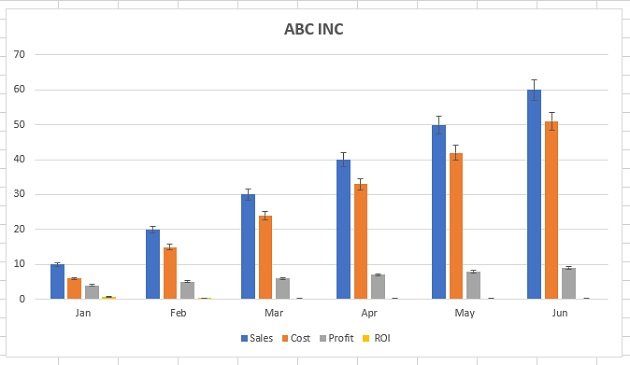
If you want to see the margin of error as a pct then use the pct error bar.
#5 Error bars (standard deviation)
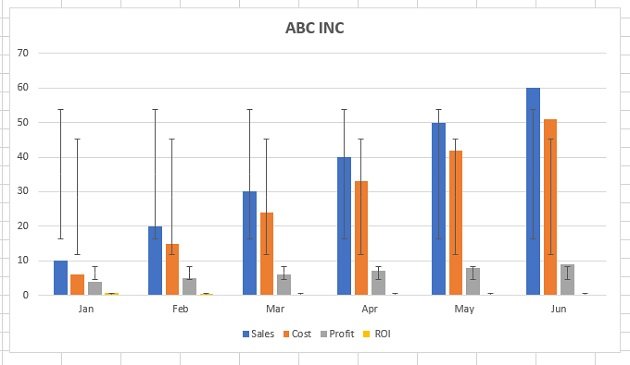
If y'all want to encounter the margin of error as a standard divergence then use the standard deviation error bar.
#6 Chief major horizontal gridlines
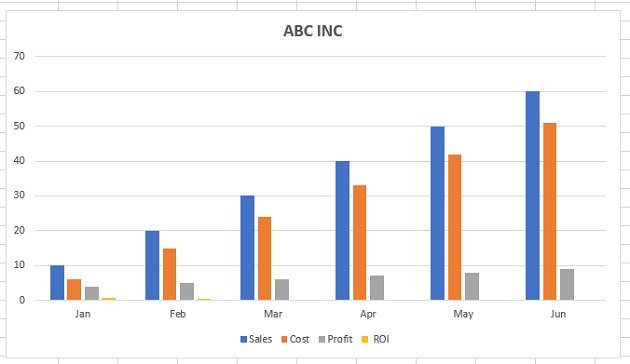
Nearly Chart Gridlines
Chart gridlines are the faint lines that announced on the plot area of a chart. They are used to make the data in a chart that displays axes easier to read. They can appear both horizontal and vertical.
#7 Principal major vertical gridlines
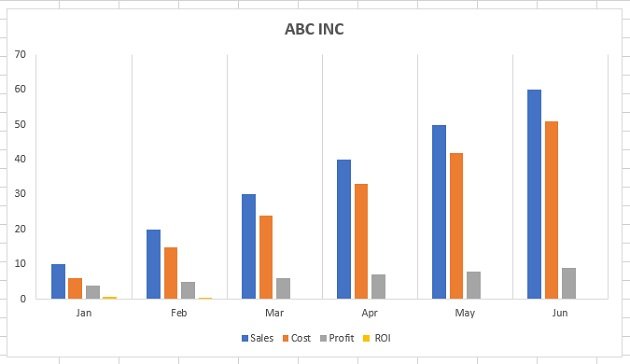
#8 Primary pocket-sized horizontal gridlines
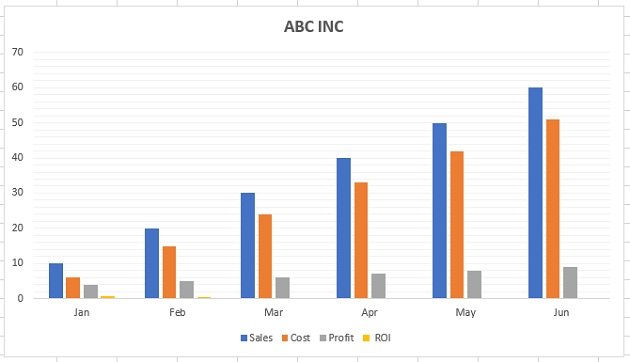
#9 Principal pocket-sized vertical gridlines
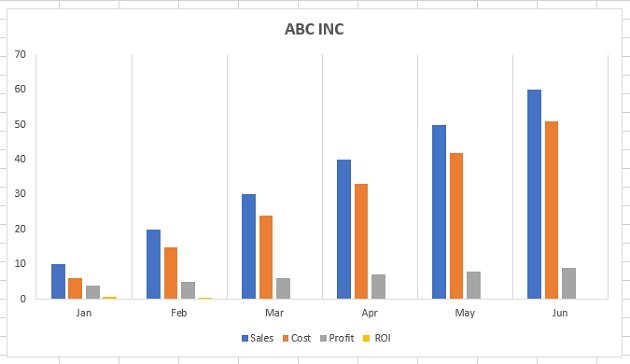
#x Linear trendline
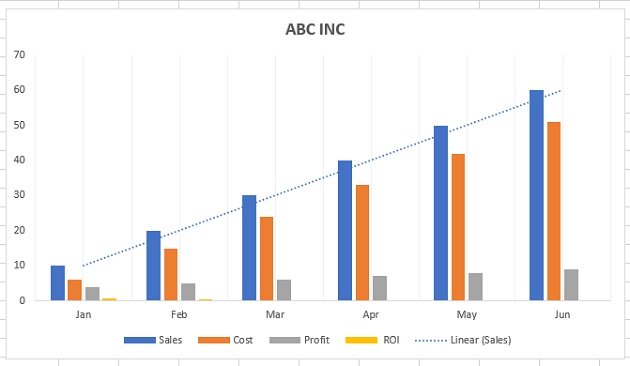
Utilise the Linear trendline if your data set is linear (resembles a directly line) and the information values are increasing or decreasing at a steady charge per unit.
Nigh Trendlines
The trendlines are used to graphically display trends in data. A tendency is a movement in a particular direction.
A trend tin be short (or seasonal), intermediate, or long term. Longer the tendency more than significant it is. For instance, a three months tendency is non as significant as three years trend.
#11 Exponential trendline
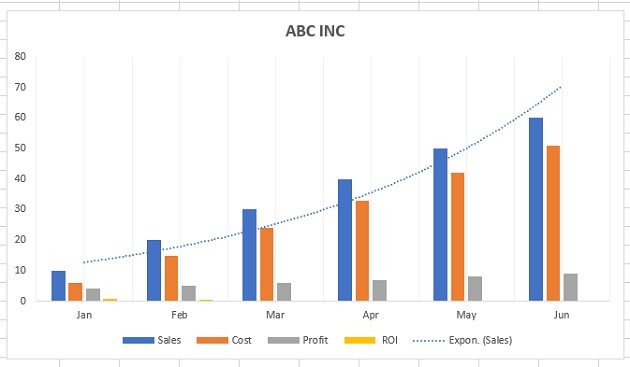
Use the exponential trendline if data values increment or decrease at increasingly higher rates.
#12 Linear forecast trendline
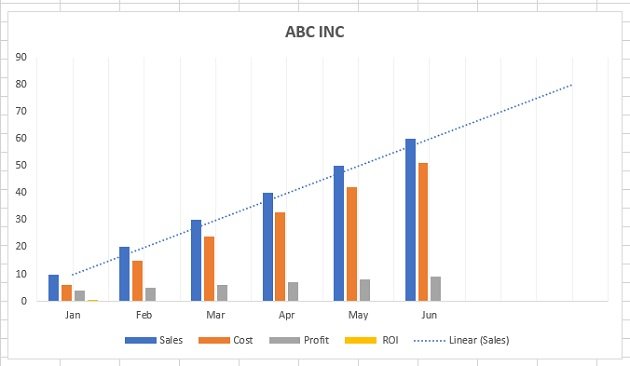
Use the Linear forecast trendline if your data prepare is linear (resembles a straight line), the data values are increasing or decreasing at a steady rate and you desire to forecast the information.
#thirteen Moving boilerplate trendline
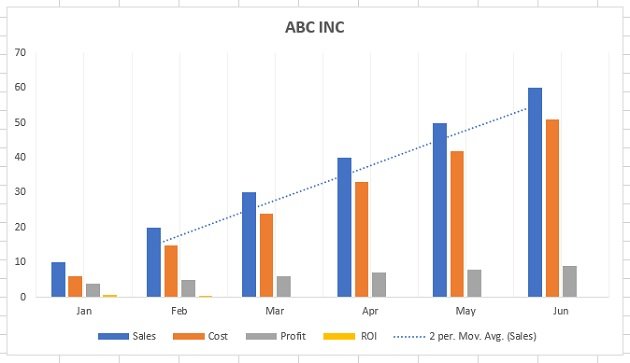
Use the moving boilerplate trendline if there is a lot of fluctuation in your data.
How to add a chart to an Excel spreadsheet?
In order to add a chart in Excel spreadsheet, follow the steps below:
Step-one: Open MS Excel and navigate to the spreadsheet which contains the information table you want to use for creating a chart.
Step-2: Select information for the chart:
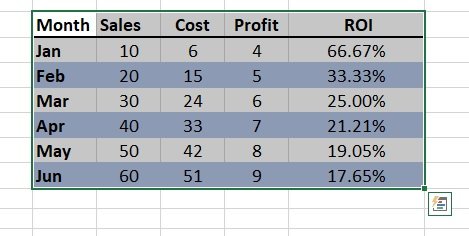
Step-3: Click on the 'Insert' tab:

Pace-4: Click on the 'Recommended Charts' button:

Stride-five: Select the chart yous want to employ from the 'Insert chart' dialog box and then click on the 'ok' button:

You should now exist able to encounter the chosen nautical chart inserted in your spreadsheet:
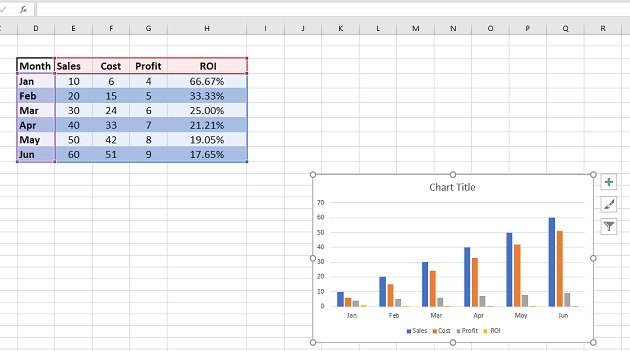
How to add, change, or remove a chart chemical element in Excel?
In social club to add together, modify or remove a chart element in Excel (2013 or above), follow the steps beneath:
Stride-1: Open MS Excel and navigate to the spreadsheet which contains the nautical chart you want to edit.
Footstep-2: Select the nautical chart and and then from the " Design ' tab click on the ' Add Nautical chart Element ' drop-down menu:


Pace-3: Select the chart element you desire to add together, change or remove from ane of the drop-down menus.
For case, if yous desire to add together a data table in your chart then click on ' Data Tabular array ' > ' With legend Keys ':
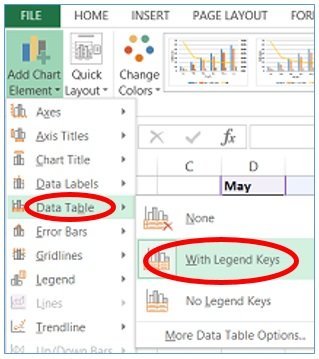
Y'all can now see your chart along with the information table:
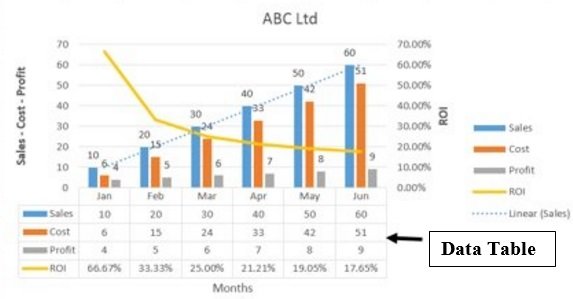
How to add a trendline to a nautical chart in excel?
Follow the steps beneath:
Stride-1: Open MS Excel and navigate to the spreadsheet which contains the nautical chart yous desire to edit.
Stride-two: Select the chart and and then from the " Blueprint ' tab click on the ' Add Chart Element ' drop-down carte du jour.
Stride-3: Click on the 'Trendline' drop-downwardly menu and so select the type of trendline you want to add to your chart:

How to change the color or mode of a chart?
Footstep-i: Open MS Excel and navigate to the spreadsheet which contains the nautical chart you want to edit.
Step-2: Select the chart and then from the " Blueprint ' tab click on the ' Change Colors ' drop-downward menu to change the colours used in your nautical chart:
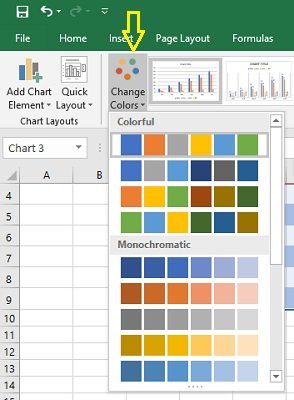
If you lot desire to change the fashion/design of the chart and then click on 1 the styles under the 'Blueprint' tab:
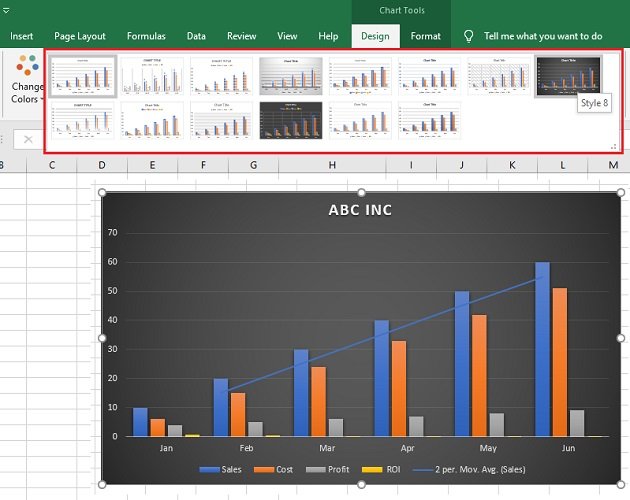
How to build data visualizations in Excel?
You can build a data visualization in excel through the following charts and graphs:
- Clustered column nautical chart
- Combination chart
- Stacked column chart
- 100% stacked cavalcade chart
- Bar chart
- Line chart
- Number chart
- Gauge nautical chart (Speedometer chart)
- Pie nautical chart
- Stacked area chart
- Venn diagram
- Scatter chart
- Histogram
- Actual vs. target nautical chart
- Bullet nautical chart
- Funnel chart
Other articles on Excel charts
- Which Chart Blazon Works All-time for Summarizing Time-Based Data in Excel
- Five Advanced Excel Charts and Graphs
- Information Visualization in Excel Tutorial
- What type of chart to use to compare data in Excel
Articles on data analysis and reporting
- Tiptop 20 reasons why people misinterpret data and reports
- Making Skilful Marketing Decisions Despite Faulty Analytics Data
- Ten tips to analyse data trends in Google Analytics
- 21 Secrets to Becoming a Champion in Information Reporting
- How to become champion in information reporting via Storytelling
- Google Analytics Dashboard Tutorial
Frequently asked questions about Excel charts
What is data visualization?
Data visualization is the presentation of data (both qualitative and quantitative data) in graphical format. Through data visualization you tin can hands: make sense of data (specially big data), classify and categorize data, find relationships among data, understand the composition of data, understand the distribution of information, understand the overlapping of data, make up one's mind patterns and trends, detect outliers and other anomalies in data, predict hereafter trends and tell meaningful and engaging stories to decision-makers.
Why is it of import to use the correct Excel chart?
If you lot use an incorrect Excel chart for your analysis, you may misinterpret data and make the wrong business and marketing decisions. If you lot use an wrong Excel nautical chart for your presentation, then stakeholders may misinterpret your charts and take wrong decisions. Therefore selecting the right Excel chart is critically of import.
What is a information series?
A data serial is a set up of related data points.
What is a data point?
Data signal represents an individual unit of information. 10, xx, 30, 40, etc are examples of information points. In the context of charts, a information signal represents a mark on a nautical chart.
What should exist the criteria for selecting an Excel chart?
The type of Excel chart you select for your analysis and reporting should depend upon the blazon of data yous desire to analyse and report and what you desire to do with data. Do you lot want to classify and categorize data or find relationships among data or empathise the limerick, distribution or overlapping of data.
What is quantitative data?
Quantitative data (also known as interval/ratio data) is the data that can be measured. For case x customers, sales, ROI, weight etc.
What is qualitative data?
Qualitative information is the data that can be classified/categorized but it tin can not be measured. For case: colours, satisfaction, rankings etc.
What is discrete data?
Information technology is quantitative data with finite number of values / observations. For instance: 5 customers, 17 points, 12 steps etc.
What is continuous data?
It is quantitative data with value / observation within a range/interval. For case, sales in the last one year.
What is nominal data?
It is qualitative information that can not be put into a meaningful social club (i.e. ranked). For example {Blueish, Yellow, Green, Red, Black}
#1 Why digital analytics is the primal to online business organization success.
#2 The number 1 reason why most marketers are non able to scale their advertising and maximize sales.
#three Why Google and Facebook ads don't piece of work for most businesses & how to make them work.
#4 Why you won't get whatever competitive advantage in the marketplace merely by knowing Google Analytics.
#5 The number 1 reason why conversion optimization is not working for your business.
#6 How to advertise on whatsoever marketing platform for Gratis with an unlimited upkeep.
#seven How to learn and master digital analytics and conversion optimization in record fourth dimension.
Source: https://www.optimizesmart.com/how-to-select-best-excel-charts-for-your-data-analysis-reporting/